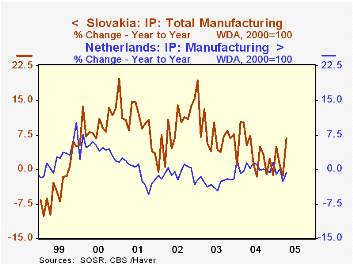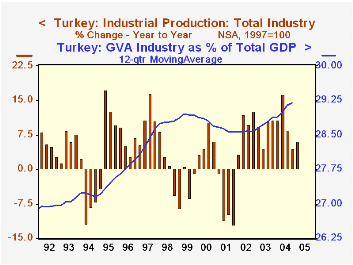 Global| Jun 08 2005
Global| Jun 08 2005Industrial Production Shows Three-Tiered Performance in Netherlands, Slovakia and Turkey
Summary
Manufacturing activity advanced in three Euro-Asian nations in April, according to industrial production data published today by national statistical offices. In the Netherlands, manufacturing output gained 1.8%, partially reversing [...]

Manufacturing activity advanced in three Euro-Asian nations in April, according to industrial production data published today by national statistical offices. In the Netherlands, manufacturing output gained 1.8%, partially reversing two down months. A generally sluggish pattern has prevailed there, so that April's amount was down 0.7% (working day adjusted) from April 2004. Total industrial output eased in the month by 0.5% as mining activity contracted.
In Slovakia, factory output surged 6% in April, a welcome gain after more than a year of basically no movement. Several diverse industries, especially machinery, textiles and wood products, contributed to the rise. Total industrial production also increased 6% in the month and was 5.5% ahead of a year ago.
For Turkey, a 3.7% rise in manufacturing production for April offset a 4.2% decline in March. Output there has been on a fairly firm uptrend so that year-on-year gains have run 5 to 6% over the past six months and were higher previously. As in Slovakia, a variety of industries are participating in this growth, although in both places, production in specific sectors varies widely from month to month.
These three countries represent three differing macro-models: the well-developed economy, the emerging economy that's fairly advanced and a more emergent emerging economy. It's intriguing to compare the position of industry within each one. In the Netherlands, industry contributes the smallest portion of the country's gross value added -- about 20%, compared with 26% for Slovakia and 29% for Turkey. Among other contrasts, finance and services come in the reverse order: they total about 25% of GDP in the Netherlands, but 15.5% in Slovakia and a mere 4% in Turkey. One might envision the mature economy as having the largest industrial sector, but on a relative basis, it's the "younger" economy, which is perhaps developing through its emphasis on manufacturing. The movement and trading of goods and services are about midway in the ranking of their contributions to GDP, with support services, such as finance, real estate and other business services coming in last in the younger economy (but first in the mature region). Relative patterns of growth fit this structure as well. Turkey has the most rapid growth rate: about 8% over the past five years, with Slovakia at 5% and the Netherlands just 0.5%-1% recently. This reminds us of the standard product cycle in an individual industry: rapid growth at first that moderates and then plateaus as the market for the product matures. Whole countries, it seems, can behave the same way.
| Industrial Production | Apr 2005 | Mar 2005 | Apr 2004 | 2004 | 2003 | 2002 |
|---|---|---|---|---|---|---|
| Netherlands: 2000 = 100 | 98.5 | 99.0 | 97.8 | 100.2 | 97.7 | 100.1 |
| Manufacturing | 95.7 | 94.0 | 96.9 | 96.2 | 95.8 | 98.5 |
| Mining & Quarrying | 111.4 | 118.6 | 108.7 | 120.2 | 103.8 | 107.1 |
| Slovakia: 2000 = 100 | 131.5 | 124.1 | 124.7 | 124.7 | 120.9 | 114.8 |
| Manufacturing | 142.7 | 134.6 | 133.3 | 134.5 | 129.9 | 120.5 |
| Mining & Quarrying | 84.1 | 86.6 | 90.8 | 94.4 | 105.5 | 111.8 |
| Turkey: 1997 = 100 | 131.1 | 126.5 | 125.0 | 123.4 | 112.4 | 103.4 |
| Manufacturing | 131.1 | 126.4 | 126.1 | 123.7 | 112.1 | 102.5 |
| Mining & Quarrying | 91.4 | 87.7 | 72.4 | 82.6 | 79.4 | 82.0 |
Carol Stone, CBE
AuthorMore in Author Profile »Carol Stone, CBE came to Haver Analytics in 2003 following more than 35 years as a financial market economist at major Wall Street financial institutions, most especially Merrill Lynch and Nomura Securities. She had broad experience in analysis and forecasting of flow-of-funds accounts, the federal budget and Federal Reserve operations. At Nomura Securities, among other duties, she developed various indicator forecasting tools and edited a daily global publication produced in London and New York for readers in Tokyo. At Haver Analytics, Carol was a member of the Research Department, aiding database managers with research and documentation efforts, as well as posting commentary on select economic reports. In addition, she conducted Ways-of-the-World, a blog on economic issues for an Episcopal-Church-affiliated website, The Geranium Farm. During her career, Carol served as an officer of the Money Marketeers and the Downtown Economists Club. She had a PhD from NYU's Stern School of Business. She lived in Brooklyn, New York, and had a weekend home on Long Island.





